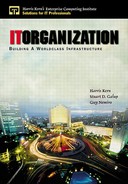Executives Out of Touch with Their Infrastructure
Executive management needs to get involved! Things are desperately out of control with the IT infrastructure. Yet they don't really know how bad it is. It's a real mess out there as depicted in Table 3-1. The problem is that executive management is overloaded and now it's become a crisis.
As a first step, management needs to dedicate one solid week to gaining an understanding of the issues their organization is facing. Just one week in the trenches with the technical staff! Executives need to spend the time with their technical staff, not management, to get the true picture. The horrors they uncover will shock them. A wakeup call that they'll never forget. This is a necessity!
But that's not enough. Executive management can establish a set of common metrics to judge how well the organization is meeting its daily, short-term and long-term objectives. By having common metrics, everyone in the organization will speak the same lingo. Think about the data centers of the 1960s and 1970s. Typically, the data center was one location where everyone worked together. Compare that to today where the applications development staffs are scattered around the world, the data center has become a compendium of different data centers, and executives are not located together. It's no wonder that people are out of touch with one another—and why executives are so easily out of touch with their organizations. The point is for everyone to be in touch with what's happening, to have up-to-the minute news and measurements for performance so that management can be active, not reactive.
With a common set of metrics that everyone in the organization understands, everyone on the IT team can immediately gauge how the team is doing against its own measurements. Our contention is that you achieve high-level RAS only when you understand what the measurements mean. Too often we've seen IT executives gloss over the nuts and bolts of making RAS possible. We've seen executives assume that RAS is the responsibility of lower level data center and network managers, without understanding the linkage of the different components that make this possible. By having a common metric system for RAS, different managers can see how different departments are performing and they can correlate results among departments.
Supporting client/server applications encompasses multiple hardware and software components that must be monitored to ensure a RAS environment. Products such as Hewlett-Packard's OpenView and Computer Associates' UniCenter can provide seamless interfaces to hardware and software products to gather operational statistics and other data. Microsoft's MSM and Paradigm's desktop software management tools can provide for desktop management and ensure that only approved software is loaded on desktops.
Information about the network computing environment is critical for RAS. The dashboard of information should include basic data points such as:
Network connection(s)
Desktop software (inventory control)
Database(s) connections
Database(s) availability (session status)
Database(s) performance
Operating system(s) availability
Operating system(s) performance
